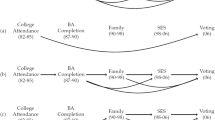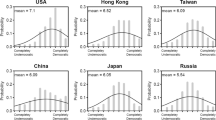Abstract
A random pivot model is used to expand the theory of policy-minded candidates. Previous results (Wittman, 1977, 1983; Cox, 1984; Hansson and Stuart, 1984) are derived under weaker assumptions. New results about candidate strategies in multiple elections are also obtained. The thrust of these results supports Calvert's (1985) finding that office-seeking and policy-mindedness are countervailing forces in election contests.
Similar content being viewed by others
References
Alesina, A. (1988). Credibility and policy convergence in a two-party system with rational voters. American Economic Review 78 (4): 796–806.
Banks, J. (1990). A model of electoral competition with incomplete information. Journal of Economic Theory 50: 309–325.
Calvert, R. (1985). Robustness of the multidimensional voting model: Candidates' motivations, uncertainty and convergence. American Journal of Political Science 29: 69–95.
Coughlin, P. (1986). Probabilistic voting models. In S. Kotz and N. Johnson (Eds.), Encyclopedia of statistical sciences, Volume 7, 204–210. New York: Wiley.
Coughlin, P. (1990). Candidate uncertainty and electoral equilibria. In J. Enelow and M. Hinich (Eds.), Advances in the spatial theory of voting, 145–166. New York: Cambridge University Press.
Cox, G. (1984). An expected-utility model of electoral competition. Quality and Quantity 18: 337–349.
Dougan, W. and Munger, M. (1989). The rationality of ideology. Journal of Law and Economics 32: 119–142.
Downs, A. (1957). An Economic Theory of Democracy. New York: Harper & Row.
Enelow, J. (1988). A bayesian analysis of a class of multi-stage decision problems. Journal of Conflict Resolution 32: 759–772.
Enelow, J. and Hinich, M. (1987). Uncertainty and the new institutionalism: The existence of a structure-induced equilibrium. Paper presented at the 1987 meetings of the Public Choice Society, Tucson, AZ.
Enelow, J. and Hinich, M. (1989). A general probabilistic spatial theory of elections. Public Choice 61: 101–113.
Friedman, J. (1990). Game theory with applications to economics. Second Edition. Oxford: Oxford University Press.
Glazer, A.B., Grofman, B. and Owen, G. (1989). A model of candidate convergence under uncertainty about voter preferences. Mathematical and Computer Modelling 12 (4/5): 471–478.
Hansson, I. and Stuart, C. (1984). Voting competitions with interested politicians: Platforms do not converge to the preferences of the median voter. Public Choice 44: 431–441.
Mitchell, D. (1987). Candidate behavior under mixed motives. Social Choice and Welfare 4: 153–160.
Nash, J. (1951). Non-Cooperative games. Annals of Mathematics 54: 286–295.
Petry, F. (1982). Vote-maximizing versus utility-maximizing candidates: Comparing dynamic models of bi-party competition. Quality and Quantity 16: 507–526.
Sydsaeter, K. (1981). Topics in mathematical analysis for economics. New York: Academic Press.
Wittman, D. (1973). Parties as utility maximizers. American Political Science Review 67: 490–498.
Wittman, D. (1977). Candidates with policy preferences: A dynamic model. Journal of Economic Theory 14: 180–189.
Wittman, D. (1983). Candidate motivation: A synthesis of alternative theories. American Political Science Review 77: 142–157.
Wittman, D. (1990). Spatial strategies when candidates have policy preferences. In J. Enelow and M. Hinich (Eds.), Advances in the spatial theory of voting, 66–98. New York: Cambridge University Press.
Author information
Authors and Affiliations
Additional information
Delivered at the 1989 Annual Meetings of the American Political Science Association, Atlanta, GA, 31 August–3 September 1989. An earlier draft of this paper was delivered at the Public Choice Society Meetings, Orlando, FL, 17–19 March 1989. I would like to thank Chuck Cameron, Don Wittman, and Henry Chappell for their comments on an earlier draft of this paper. I am greatly indebted to Gary Cox for his helpful suggestions in revising this paper. I would also like to thank three anonymous referees.
Rights and permissions
About this article
Cite this article
Enelow, J.M. An expanded approach to analyzing policy-minded candidates. Public Choice 74, 425–445 (1992). https://doi.org/10.1007/BF00137688
Accepted:
Issue Date:
DOI: https://doi.org/10.1007/BF00137688




